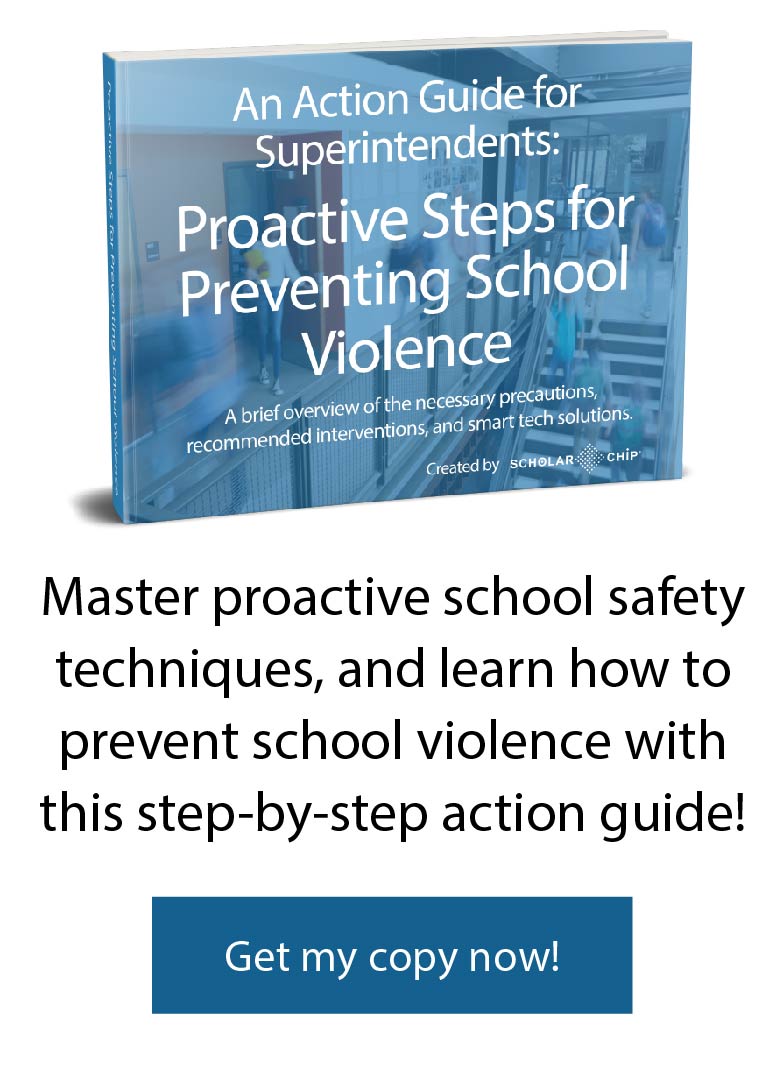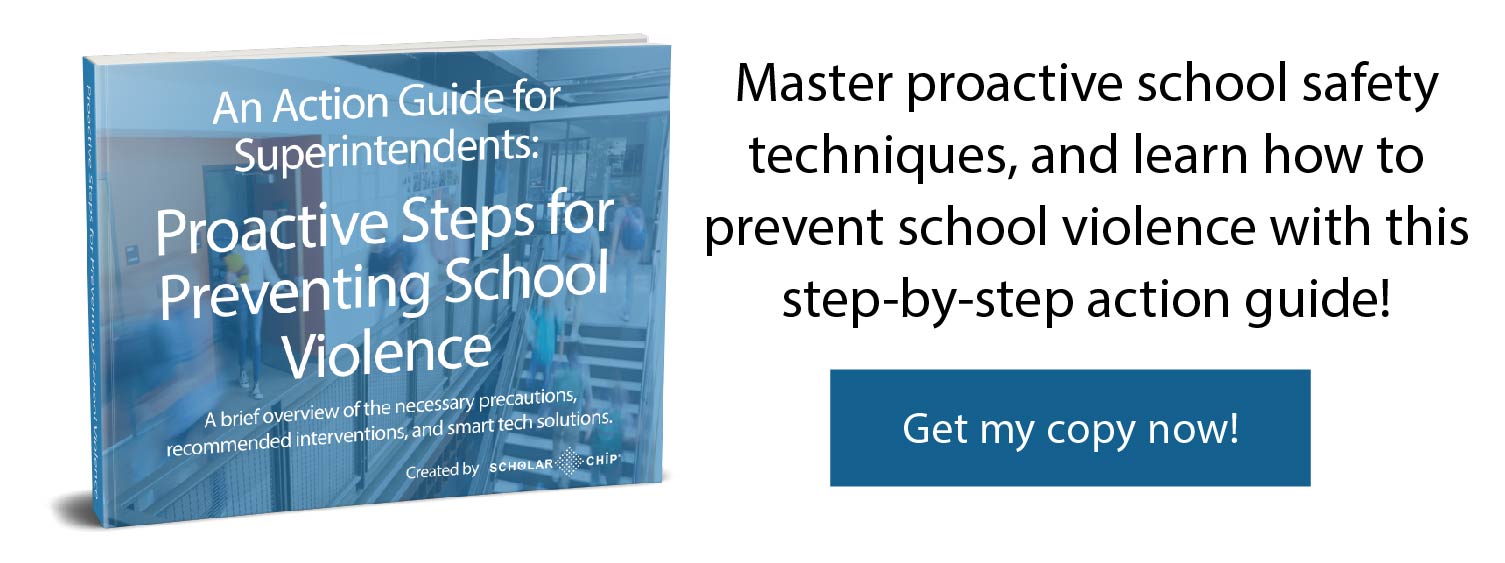Focusing on fine-tuning your school’s reaction plan to school threats and other unanticipated events isn’t always the best use of your resources. Wouldn’t it be much better to avoid school threats, rather than reacting to them? Preventing dangerous situations on campus is the ideal scenario for superintendents. Unfortunately though, according to the Educator’s School Safety Network, school threats come from students about 81 percent of the time.
The same ESSN report revealed that after the tragedy at Margory Stoneman Douglas High School in Parkland, Florida, 43 percent of all threats made during the entire 2017-18 school year occurred in the 30 days following that shooting. So it’s important to be aware of what’s happening elsewhere regarding school threats, and be prepared for threats to be made by students “inspired” by other school attackers.
To prevent school threats, the National Education Association recommends schools focus on creating a safe and welcoming learning environment and providing quality behavioral health services, and we agree. Here’s the best advice for how you can reduce school threats and violence by crafting an effective behavior intervention plan.
Create an effective behavior intervention plan
The National Association of School Principals outlines a systematic approach to assessing what a school’s behavioral health services needs are, and then developing programs that meet those needs.
Their recommendations include:
- Evaluate the specific types of violence that occur across your campus, the context in which these events occur, the profiles of the typical perpetrators and victims, and how effective existing discipline measures have been. Based on this assessment, school leadership should be able to determine where the weaknesses are.
- Consider the strengths and talents of your existing staff and how you can leverage those gifts. As your school develops and implements new safety and behavior intervention plans, you will need to have the right people playing the proper roles. School-wide anti-violence initiatives will require the buy-in and participation of all staff. These programs will teach students how to resolve differences peacefully and help establish a more positive school culture and atmosphere.
- Put additional effort into creating a positive culture, and school environment. This plan should bring together staff, community members, parents, and students to collaborate on projects that enhance school safety and student engagement. Involving students in this process creates a way for them to become invested in their school and encourages their buy-in with your new behavior plans.
- NASP takes it one step further and recommends school-wide anti-violence programs. Thinking about the scope of all these measures, and the effort it will take on the part of every staff member can feel overwhelming. But school safety must jump to the front of the line, right next to curriculum development and student engagement, for schools to serve their students’ needs.
- Once you have a behavior intervention plan in place, administration and counselors must respond quickly and appropriately to every threat made by a student. Although NASP has found that few student threats of violence result in violent acts, those threats still provide an opportunity to the needs of the student making the threat. Each instance is also a great time to collect more data and prepare better for future threats.
- High school counselors, in particular, are overwhelmed with large student populations, standardized testing schedules, and college-related events. But tending to students’ behavioral health needs cannot be put off in favor of other pursuits. Schools need to do a better job of providing mental health services and support programs to students who need them. Assess your counseling staff, figure out ways to redistribute duties, and make sure your students with mental health concerns are being served.
Can technology help with behavior intervention plans?
To prevent violence and threats on and even off campus, schools must implement behavior intervention plans that enable staff to compile and share their concerns. When patterns reveal themselves, a counselor or administrator is better equipped to address those concerns with the student and parent. Once the administration is sure the student is not a threat to others, the student should take some ownership of their behavior improvement plan.
An Alternative Behavior Educator
ScholarChip’s behavior intervention module, ABE is an integrated, tech-driven behavior educator program that provides school officials with a central location to e-file their incident reports and other student feedback. Administrators and school counselors can receive automated notifications when a student’s e-file grows. When it’s time for an intervention, a principal can pull up all of a student’s behavior records from within the ABE system and discuss them with the student and parent.
Once the student and parent are clear on behavior expectations going forward, the principal can assign learning modules to the student right within ScholarChip’s ABE. It will be up to the student to complete the modules, and the principal will be notified when those tasks are completed. And with the student flagged in the system, school counselors can set up a schedule to meet privately and regularly with the student. For students with emotional or behavioral disturbances, ongoing counseling can go a long way toward preventing violence on campus.
Develop a robust, effective behavior intervention plan
The National Center for Education Statistics reports that during the 2015-16 school year, 69 percent of schools experienced at least one violent incident on campus. Until our communities can get these threats and tragedies under control, school leaders cannot afford to let school safety slide. Schools must implement programs that foster positive and empathetic learning environments. Also, ongoing training for all staff must remain a priority. That training should cover identifying students in crisis, and the school’s policy on how to intervene with a student who is making or may make a violent threat. ScholarChip’s Alternative Behavior Educator can create a clear and consistent avenue of communication across all staff members.
ScholarChip is an all-in-one platform solution to comprehensively help reduce school threats and address the important issues surrounding school safety and violence. Data from students, faculty, and stakeholders are leveraged to manage school access, attendance, and behavior management through the platform’s tools to improve campus climate, promote safety, and prevent violence.
To learn more about how you can prevent school violence and threats across your campuses through a behavior intervention plan, schedule a 1-on-1 strategy session with one of our specialists today!


